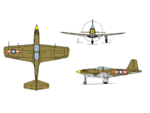Shortround6
Lieutenant General
Space in front of the landing gear is pretty much used up by the reduction gear.
The is length and there is length.



Granted these a re P-40 pictures.
The standard Allisons tend to "taper" at lot more at the rear. With both engines the length included some "accessories" but the two stage Merlin had a lot more bulk in the lower rear. Engine bays were not 30 in wide, 36 in high 80 in long empty boxes with square corners.
The is length and there is length.
Granted these a re P-40 pictures.
The standard Allisons tend to "taper" at lot more at the rear. With both engines the length included some "accessories" but the two stage Merlin had a lot more bulk in the lower rear. Engine bays were not 30 in wide, 36 in high 80 in long empty boxes with square corners.

